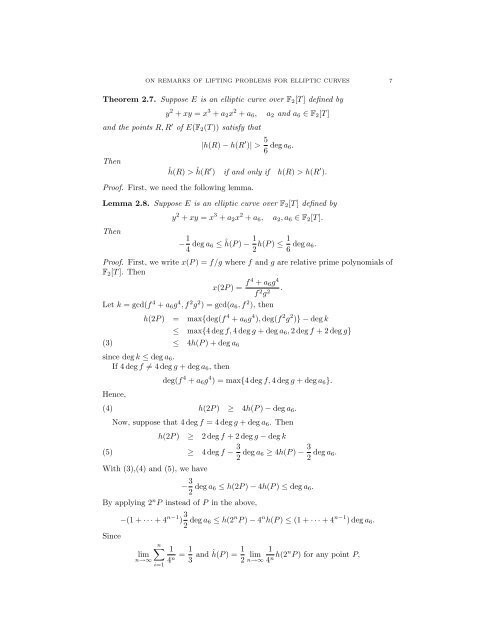ON REMARKS OF LIFTING PROBLEMS FOR ELLIPTIC CURVES 1 ...
ON REMARKS OF LIFTING PROBLEMS FOR ELLIPTIC CURVES 1 ...
ON REMARKS OF LIFTING PROBLEMS FOR ELLIPTIC CURVES 1 ...
You also want an ePaper? Increase the reach of your titles
YUMPU automatically turns print PDFs into web optimized ePapers that Google loves.
<strong>ON</strong> <strong>REMARKS</strong> <strong>OF</strong> <strong>LIFTING</strong> <strong>PROBLEMS</strong> <strong>FOR</strong> <strong>ELLIPTIC</strong> <strong>CURVES</strong> 7<br />
Theorem 2.7. Suppose E is an elliptic curve over F 2 [T ] defined by<br />
y 2 + xy = x 3 + a 2 x 2 + a 6 , a 2 and a 6 ∈ F 2 [T ]<br />
and the points R, R ′ of E(F 2 (T )) satisfy that<br />
|h(R) − h(R ′ )| > 5 6 deg a 6.<br />
Then<br />
ĥ(R) > ĥ(R′ ) if and only if h(R) > h(R ′ ).<br />
Proof. First, we need the following lemma.<br />
Lemma 2.8. Suppose E is an elliptic curve over F 2 [T ] defined by<br />
Then<br />
y 2 + xy = x 3 + a 2 x 2 + a 6 , a 2 , a 6 ∈ F 2 [T ].<br />
− 1 4 deg a 6 ≤ ĥ(P ) − 1 2 h(P ) ≤ 1 6 deg a 6.<br />
Proof. First, we write x(P ) = f/g where f and g are relative prime polynomials of<br />
F 2 [T ]. Then<br />
x(2P ) = f 4 + a 6 g 4<br />
f 2 g 2 .<br />
Let k = gcd(f 4 + a 6 g 4 , f 2 g 2 ) = gcd(a 6 , f 2 ), then<br />
(3)<br />
h(2P ) = max{deg(f 4 + a 6 g 4 ), deg(f 2 g 2 )} − deg k<br />
≤ max{4 deg f, 4 deg g + deg a 6 , 2 deg f + 2 deg g}<br />
≤ 4h(P ) + deg a 6<br />
since deg k ≤ deg a 6 .<br />
If 4 deg f ≠ 4 deg g + deg a 6 , then<br />
Hence,<br />
(4)<br />
deg(f 4 + a 6 g 4 ) = max{4 deg f, 4 deg g + deg a 6 }.<br />
h(2P ) ≥ 4h(P ) − deg a 6 .<br />
Now, suppose that 4 deg f = 4 deg g + deg a 6 . Then<br />
h(2P ) ≥ 2 deg f + 2 deg g − deg k<br />
(5)<br />
≥ 4 deg f − 3 2 deg a 6 ≥ 4h(P ) − 3 2 deg a 6.<br />
With (3),(4) and (5), we have<br />
− 3 2 deg a 6 ≤ h(2P ) − 4h(P ) ≤ deg a 6 .<br />
By applying 2 n P instead of P in the above,<br />
−(1 + · · · + 4 n−1 ) 3 2 deg a 6 ≤ h(2 n P ) − 4 n h(P ) ≤ (1 + · · · + 4 n−1 ) deg a 6 .<br />
Since<br />
lim<br />
n∑<br />
n→∞<br />
i=1<br />
1<br />
4 n = 1 3 and ĥ(P ) = 1 2 lim<br />
n→∞<br />
1<br />
4 n h(2n P ) for any point P,













